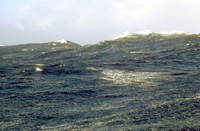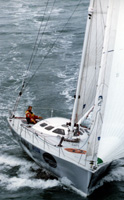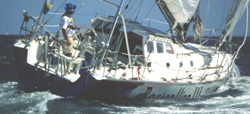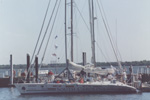
© Photo Richard Konkolski

© Photo Richard Konkolski
There were three strong cold fronts lying over Indian Ocean. One off South Africa with winds of 60 knots, second off Western Australia's Cape Leeuwin and third off Tasmania, respectively, all with strong westerly winds. That meant that if you were anywhere along Leg 2 course between Africa and Tasmania, you were getting or will get very strong wind and monster sea.
 Mark Thiercelin © Photo Marek Slodownik
Mark Thiercelin © Photo Marek Slodownik
Soldini at front kept quiet but on another end Argos Alarm System on Thiercelin's boat
went on. After short communication it showed that Mark had no idea about that problem. The
pressure of big waves and constant shaking had to have activated alarm. Mark and his boat
were OK.
Isabelle Autissier was also handling her situation well. She phoned: "The wind is blowing 30-35 knots, but it isn't from astern, so I'm in no danger of jibing. In these conditions, I can risk going fast. At the moment, I'm doing better than 23 knots. I absolutely must take advantage of this front, so as to avoid finding myself south of Tasmania on Thursday, with the next storm coming in. Right now, there is a depression every two days, and they are very far."
 Hall's Gartmore © Photo Marek Slodownik
Hall's Gartmore © Photo Marek Slodownik
All Indian Ocean was getting messy. Josh Hall who was 1235 miles behind Soldini reported:
"The southern ocean arrived last night in a serious way. During the afternoon and
early evening the wind gradually built along with the seas and by midnight the anemometer
was showing a solid 38 knots with ever lengthening gusts up to 50 knots. Our yacht became
more of a submarine as we powered along, surfing on the growing swell, hitting 25-27 knots
boat speed. Most of the time solid water was gassing across the cabin windows and into the
cockpit. We already had 3 reefs in the main and a couple of rolls in the solent and I was
umming and arrring about dropping the main completely as we were starting to feel
increasingly on the edge."
In Class II Mouligne had great hopes of winning this leg. He wrote: "The last 12 hours have been rough. A strong cold front is passing through and the wind is blowing around 45 knots. This is only an estimate since my wind indicator ceased to function a few days ago. I have a triple reef in the main and a small piece of jib up, and Cray Valley feels overpowered at times. The seas are big but not dangerous and we are still moving at 10 to 12 knots. It's uncomfortable and stressful; sometimes a big wave just throws the boat on its side and everything starts flying down below… The next step will be to take the main down, but the speed will then go down drastically and I do not feel that it is necessary yet…. I am now less than 3,000 miles from Auckland."
 Magellan Alpha
Magellan Alpha
Michael Garside already dropped to 152 miles behind Mouligne and he had a lot of trouble trying to keep going fast: "I have seen bigger seas than these, but before this blow is finished I suspect I won't have. It seems this show is going to run. I crossed the second waypoint line at 46S last night at 2122Z and, having sent my confirmatory message to the Race Operations Center in Charleston, prepared to gybe onto an Easterly heading. I was a bit apprehensive because it was blowing 35 knots and Magellan Alpha was swinging wildly all over the place. At first it went well - my gybing drill is much rehearsed. But I was too slow and before I had completed the maneuver we had gybed back and were in a mess with Alphie pinned flat on the sea… Back up again, and away on a wild ride with two reefs in the main, I tried to set a course not too far off the wind to give us a chance of avoiding more uncontrolled gybes. No such luck… Three more gybes to each side in the space of a few minutes and I decided, if I didn't get the main down I soon would have no spars to carry it… After a very wet cold hour I succeeded. I crawled back along the deck swearing and scolding myself for the obvious. The Southern Ocean is not the place to experiment with new, unproven ideas… The wind is now up to 40Knots, gusting 50, I keep putting off the moment to rehoist the main to the third reef. Magellan Alpha does not like being pulled along by the staysail alone. Our speed is up and down like a yo-yo between 8 knots and 20. But it is erratic and I am continuing to lose miles to the fleet leaders. On the other hand, if I raise the main, I risk major damage to the rig because I cannot hold a straight course. I am burning up with frustration. And from what I can read of the weather, I'm going to be on this roller coaster for another three days. By then, I feel sure, I will have seen seas bigger than I have before."
Only Neal Petersen 2,000 back had a light condition for the moment: "The last 24 hour has been frustrating. Most of the time the sea is a slick shiny surface of no wind. For a while this morning it did get up to 20 knots and we were clipping along, then it died away for about 10 hours and we were going in circles on the swell. Now it is up to 4 knots and we have steerageway." Most probably everything will have changed for him in very short time.
 Rapscallion III © Photo Billy Black
Rapscallion III © Photo Billy Black
George Stricker trying to get back to Cape Town decided to take it more easily. He pulled
down all sails and bare poled he waited for better weather. "From Rapscallion - winds
to 50 knots, high seas, barometer 960, jib sheet parted, small jib damaged, will lay a
hull until a drop in the wind, I have one heavy jib to get me to Cape Town, the risk is to
great to remaining sail to attempt to sail, all is well other wise."
Robin Davie reported from far back of the whole fleet: "Some good Southern Ocean type weather hasn't taken long to find me, and its been puffing up to gale force since early morning with gusts and rain squalls into the 40 knot range… Last nights westerly winds gave us a good southeasterly course allowing us to stay out in deep water off the Agulhas Bank… Increasing winds saw the reefs go into the mainsail and furls into the genoa, so that by first light we were down to 3 reefs in the mainsail, and about half the inner staysail furled on its roller. The seas were building, and these aren't the seas created by wind, they are the swells from the southern ocean, and the low pressure storm centers hundreds of miles down south."
 South Carolina © Photo Marek Slodownik
South Carolina © Photo Marek Slodownik
Robin left Cape Town three days ago, two weeks behind the rest of the fleet. He predicted
that it would take him 32 days to finish the leg. He must finish before January 28, 1999
to be able to continue the race. He would have to average over seven knots all the way to
Auckland. By the last report he was doing just that.
Place |
Skipper |
Boat |
Latitude |
Longitude |
Dist. to go |
Speed |
Dist. to first |
Time |
1 |
Soldini |
Fila |
45 35S |
142 11E |
1715 |
15.2 |
0 |
2140 |
2 |
Golding |
Team Group 4 |
47 10S |
140 26E |
1810 |
14.5 |
95.6 |
2244 |
3 |
Thierceli |
Somewhere |
46 29S |
138 06E |
1893 |
12.1 |
178.5 |
2140 |
4 |
Autissier |
PRB |
43 03S |
129 00E |
2258 |
13.1 |
543.6 |
1844 |
5 |
Hall |
Gartmore |
47 42S |
112 09E |
2950 |
11.2 |
1235.3 |
2140 |
6 |
Konioukhov |
Mod.Univ.Human. |
44 50S |
046 47E |
5607 |
8.7 |
3892.4 |
2140 |
Place |
Skipper |
Boat |
Latitude |
Longitude |
Dist. to go |
Speed |
Dist. to first |
Time |
1 |
Mouligne |
Cray Valley |
45 57S |
117 23E |
2746 |
11 |
0 |
2144 |
2 |
Garside |
Magellan Alpha |
46 30S |
113 39E |
2898 |
9.8 |
151.9 |
2144 |
3 |
Van Liew |
Balance Bar |
45 39S |
102 41E |
3355 |
11.6 |
608.5 |
2144 |
4 |
Yazykov |
Wind of Change |
48 06S |
101 00E |
3422 |
7.5 |
676.1 |
2144 |
5 |
Saito |
Shuten-dohji II |
47 54S |
069 09E |
4685 |
3.4 |
1938.6 |
2144 |
6 |
Petersen |
No Barriers |
46 34S |
068 12E |
4746 |
5.3 |
1999.7 |
2144 |
7 |
Hunter |
Paladin II |
45 19S |
064 25E |
4920 |
7.9 |
2176.7 |
2144 |
8 |
Davie |
South Carolina |
44 35S |
035 42E |
6023 |
7.5. |
3876.7 |
2144 |
9 |
Stricker |
Rapscallion III |
Retired |
0 |
0 |
0 |
0 |
0 |
Copyright © Richard Konkolski
Return back to Second Leg
Return back to First Leg